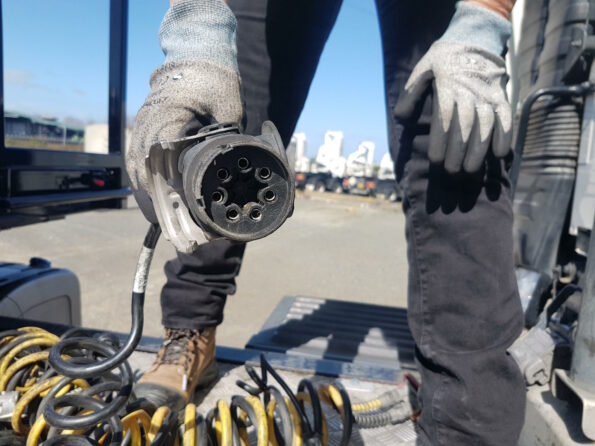ABS (antilock braking system) has been available on heavy commercial vehicles for many years. It has been superseded by EBS (electronic braking system).
ABS
ABS prevents a vehicle’s wheels from locking when the brakes are applied. A wheel locks as soon as the force of the brakes is greater than the friction between the tyre and the road. The road doesn’t need to be slippery or wet for this to happen. ABS only happens on the prime mover and doesn’t provide for brake compatibility (balance) for combination vehicles such as truck and trailer, b-doubles, road trains and semitrailers. This means that ABS is not applied consistently across all axles, leading to a poorer performance than could be expected. This limitation led to the development of EBS.
EBS
EBS provided brake compatibility for all wheels in the combination. The brakes are activated electronically meaning the response time is significantly quicker than conventional air braking systems.
EBS’s advantage is being able to stop a truck combination one whole vehicle length shorter at highway speeds, i.e. at least 20 metres.
EBS is controlled using two extra wires in the socket and plug in the electrical suzi cable (pin 6&7). The air braking system is overridden and instead becomes a backup, fail-safe should the EBS malfunction.
When both the prime mover and trailer(s) (or truck and dog trailer) are equipped with EBS, there is constant communication between them to determine what’s happening in terms of the axles and braking. When he brakes are applied, they react as one.
Plugs and leads

ABS systems usually have 5 pins in the plug, whereas EBS and multi-volt systems have 7 pins.
While it’s a crucial system, it’s also prone to damage if the cables and plugs are not looked after correctly. Both the cable and plug are exposed to damage by the weather and should be stored out of the weather when not in use. Bent pins, cracked wires and dirt inside the plug are common issues.
When plugging in these systems, ensure you have the right lead for the job. ABS leads will be 12V or 24V depending on the prime mover. However, EBS is multi-volt and will have 7 pins.
Warnings
If ABS or EBS isn’t working, it’s usual for the truck’s display to show an ABS warning symbol on the dashboard. This means that the ABS or EBS system is not functioning and the vehicle has reverted back to a fully mechanical air braking system. You must take your truck to a service agent to have this repaired; bear in mind that the light might not go off until you are travelling at more than 10km/h.
Multicombinations may need a CAN (controller area network) or CAN-bus router or repeater for the trailers. This transmits data and conditions between the prime mover and trailers.
If a prime mover doesn’t have EBS fitted, a TRM (trailer response management) unit can be fitted which provides a CAN signal to the trailers.
Other systems that trucks may have is TEBS (trailer EBS) and RSC (rollover stability control).
